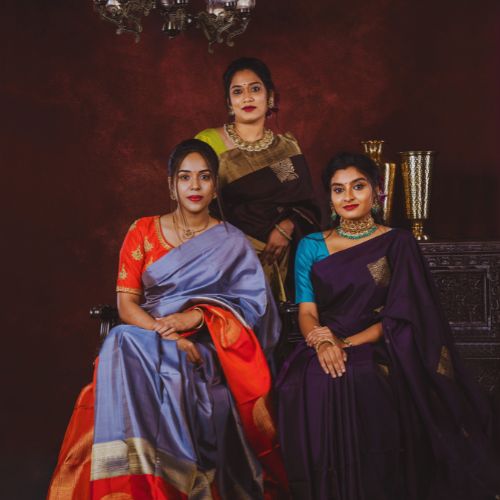Stripes And Checks: Why Geometry Never Goes Out of Style
Some patterns never fade; they simply adapt. In the realm of Kanjivaram and Chettinad sarees, stripes and checks have remained central to South Indian weaves for generations. They’re not flashy or trendy. Instead, they provide something more lasting: balance, structure, and timeless appeal.
At JP Silks, we’ve seen how these geometric motifs, rooted in tradition, feel just as relevant today as they did in our grandmothers’ wardrobes. Let’s examine why patterns like kattam (checks), vari (stripes), and other grid-inspired designs continue to captivate.
Checks: A Pattern That Grounds and Connects

There’s something comforting about checks. Whether it’s the bold red-and-black squares of Chettinad cottons or the intricate zari kattams of a Kanjivaram silk, checks are familiar and enduring. They’re also rich in heritage. In Tamil Nadu, the kattam isn’t just a pattern—it represents culture. Generations of women have worn checked sarees to temples, markets, weddings, and everyday activities.
Within this simple geometry lies endless variation. You have Puliyam-Kottai Kattam (checks the size of tamarind seeds), Muthu Kattam (looking like pearls), and Kasa-Kasa Kattam (fine, poppy-seed-like patterns). Each offers a different character to the saree—bold, delicate, or subtly elegant.
What we love most is how checks adapt beautifully across fabrics and occasions. A cotton kattam saree feels light and easy on a summer morning, while a silk kattam with zari glints can catch attention at a festive gathering. You can pair them with a classic contrast blouse or explore prints and textures—these squares will work well.
Stripes: Minimalism with Movement
Stripes, or vari, are often underestimated. They may seem basic, but their strength lies in how they affect the drape of a saree. Vertical stripes guide the eye along the fabric, giving a sense of height and flow. Horizontal stripes create calmness, structure, and sometimes, a touch of drama.
In South Indian sarees, stripes appear in both subtle and bold forms. Vazhaipoo vari, inspired by the banana flower, is common in temple sarees. Zari stripes along cotton-silk blends add just enough shine without overpowering the look. Even tone-on-tone stripes in earthy colors can elevate a simple drape into something polished.
Stripes also provide a sense of rhythm. Their repetition gives a softness and order that make the saree feel grounded. Like checks, they fit into any setting—be it a Monday morning meeting or an evening with family and friends.
Geometric Weaves: The Grid as a Design Language
 Beyond checks and stripes, South Indian sarees—especially Kanjivarams—often utilize geometric designs as a visual foundation. There’s a precise layout to these weaves. You’ll see repeated squares, symmetrical lines, diamond patterns (vaira oosi), or zigzags arranged in mathematical sequences. These choices are not just artistic; they tell a story through structure.
Beyond checks and stripes, South Indian sarees—especially Kanjivarams—often utilize geometric designs as a visual foundation. There’s a precise layout to these weaves. You’ll see repeated squares, symmetrical lines, diamond patterns (vaira oosi), or zigzags arranged in mathematical sequences. These choices are not just artistic; they tell a story through structure. In many ways, geometry becomes the weaver’s language. The colors, spacing of checks, and thickness of stripes all work together to create balance and contrast. In Kanjivarams, where every detail is carefully planned, geometry plays a vital role.
What’s fascinating is how these traditional weaves echo other aspects of Tamil culture. Consider the padi kolam drawn in front of homes—structured, symmetrical, and welcoming. Or think of the layout of temple corridors. Geometry isn’t merely a design trend here; it’s a way of life.
Why It Never Goes Out of Style
Stripes, checks, and geometric patterns are timeless. They aren’t influenced by trends or social media; they’re based on function, craft, and emotion. These patterns are easy to wear, yet never dull. They allow for personal expression and blend the old with the new.
They also carry memories. A kattam saree passed down from a grandmother might now be worn with a crop blouse and oxidized earrings. A simple striped cotton once used for college might now accompany someone to a boardroom. Geometry holds space for all these stories without needing redesign.
The JP Silks Way: Rooted, Refined, and Reimagined
At JP Silks, we value these patterns not only for their visu appeal but for their deeper meaning. We closely collaborate with our weavers to preserve traditional techniques while introducing fresh interpretations—whether through color, fabric blends, or subtle zari highlights.
Whether you seek a bold kattam cotton, a muted stripe in pastel silk, or a Kanjivaram that reinterprets structure through grid-inspired design, our collections are curated with timelessness in mind.
Because at the end of the day, geometry doesn’t just shape sarees; it shapes memories.


